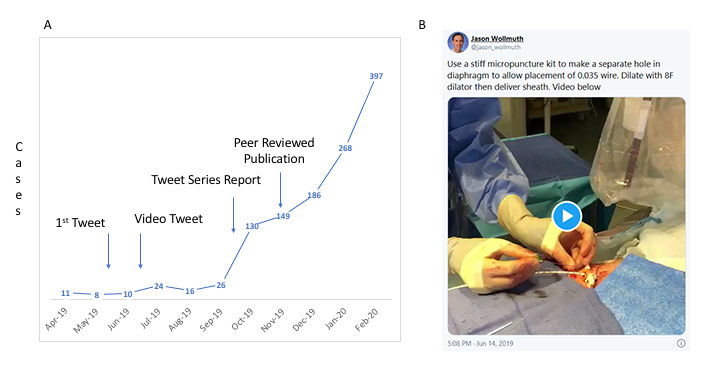22 Dec 2020
IMPELLA supported PCI via a single access sheath - Introduction and rapid adoption: the Power of Social Media
Supported by the EuroIntervention Journal
Authors
Aaron V. Kaplan1, Jason Wollmuth2 and Duane S. Pinto3
Case summary
The rapid growth of interventional cardiology has been driven in part by the ability to share and teach new techniques. The availability of social media adds game-changing tools to this process. This manuscript examines Impella single access technique (SAT), which provides a case example of the central role social media can play in the introduction of a new interventional approach.
SAT allows for PCI to be performed through a guide catheter placed alongside a previously placed Impella CP (Abiomed, Danvers MA) within the Impella access sheath. After Impella placement, micropuncture of the access sheath hemostasis valve allows for introduction of a vascular sheath through which PCI can be performed (1,2).
We tracked initial postings on Twitter, FDA filings and monthly usage data from the device manufacturer.
SAT first appeared on Twitter in May 2019 which was followed by a video Tweet (Jun 2019) and clinical series (Sep 2019) with first peer-reviewed publication in Nov 2019 (2). In the 5 month period following the initial posting, single arterial access increased from 8 to 397 per month (Fig 1). As of Sep 21, 2020, the video tweet was viewed 9.3K times. After becoming aware of this technique, the manufacturer performed formal benchtop testing which was used to update its Instructions-For-Use to include a description of SAT (3).

Figure 1: Social Media and The Introduction of Single Access Technique
Panel A: Single Access Technique usage plotted over time. Arrows indicate first tweet, video tweet, series reported on twitter and peer reviewed publication.
Panel B: Screen shot of first video tweet (June 14 2019) accessed on September 21, 2020 with 9.3K views logged.
Though other interventional techniques have been introduced via social media, e.g. distal radial access, because SAT is linked to use of a specific device (IMPELLA) it provides the ability to characterize the temporal association between Tweets and technique uptake (4).
Furthermore, we believe this to be the first example of an interventional technique which was introduced via social media resulting in labelling changes. The use of SAT, presented an unusual challenge for the device manufacturer. Manufacturers of medical devices like the Impella CP are required by FDA to monitor usage and are precluded from promoting ‘off label’ use. This labelling update allows the manufacturer to promote SAT by providing technical support, at Company-sponsored meetings and through advertisement (5).
Social media is having far-reaching effect on how the clinical and patient communities learn about new and established treatments. Though the use of social media provides a highly efficient way to introduce new interventional techniques, e.g., distal radial access and SAT, it does so without the scrutiny provided by peer review. Going forward, it will be essential for the community to require follow-up of social media reports with publication in peer-reviewed journals.
The introduction and dissemination of SAT provide an example of the far-reaching impact of social media on our practice of medicine. The impact of social media is likely to increase within the current context of COVID-19.
Acknowledgement
The authors wish to acknowledge Seth Bilazarian, M.D, (Chief Medical Officer, Abiomed) who provided the usage data.
Conflict of interest statement
Dr. Kaplan receives support for the Dartmouth Device Development Symposium from Abiomed.
Drs Wollmuth and Pinto are Consultants to Abiomed.
Affiliations
- Heart and Vascular Center Dartmouth-Hitchcock Medical Center/Geisel School of Medicine at Dartmouth, Lebanon, NH.
- Providence Heart and Vascular Institute, Portland OR,
- Beth Israel-Deaconess Medical Center/Harvard School of Medicine, Boston MA
References
- Wollmuth J, Korngol E, Croce K, Pinto DS. The Single-access for Hi-risk PCI (SHiP) Technique Catheter Cardiovasc Interv. 2019 Oct 26. doi: 10.1002/ccd.28556.
- Wollmuth, J Use a stiff micropuncture kit to make a separate hole in diaphragm to allow placement of 0.035 wire. @jason_wollmuth Jun 14, 2019 (https://twitter.com/jason_wollmuth/status/1139550156032897026?lang=en) (Accessed Sep 21, 2020)
- IMPELLA CP INTRODUCER Hemostatic Peel-Away Introducer System with Infusion Sideport. Instructions for Use. Abiomed, Inc. Danvers, MA (Accessed 25 May 2020)
- Kiemeneij F. Left distal transradial access in the anatomical snuffbox for coronary angiography (ldTRA) and interventions (ldTRI). EuroIntervention 2017;13:851–7.
- Journal of the American College of Cardiology-Cardiovascular Interventions, 2020;8 (Volume 15) back cover.




3 comments
Excellent insights into the future of knowledge dissemination in interventional cardiology!
Very nice article highlighting the power of social media and the importance for manufacturers to monitor real-world usage!
The impact of social network on interventional cardiology is astonishing. Is Twitter the new platform for fellow and peer-to-peer education? Aside from the obvious advantages, the real question is... Is the discussion on Twitter the new peer review?